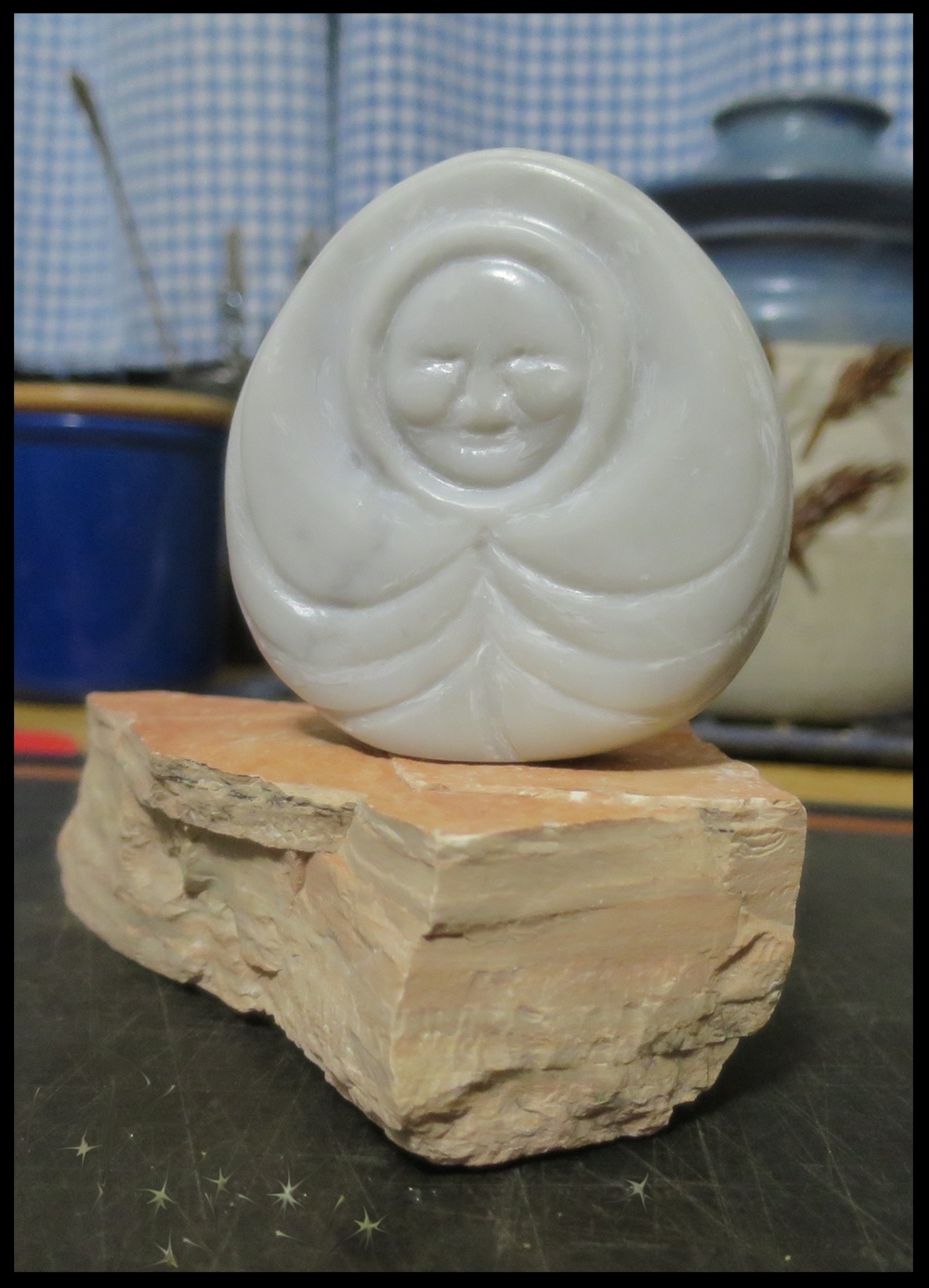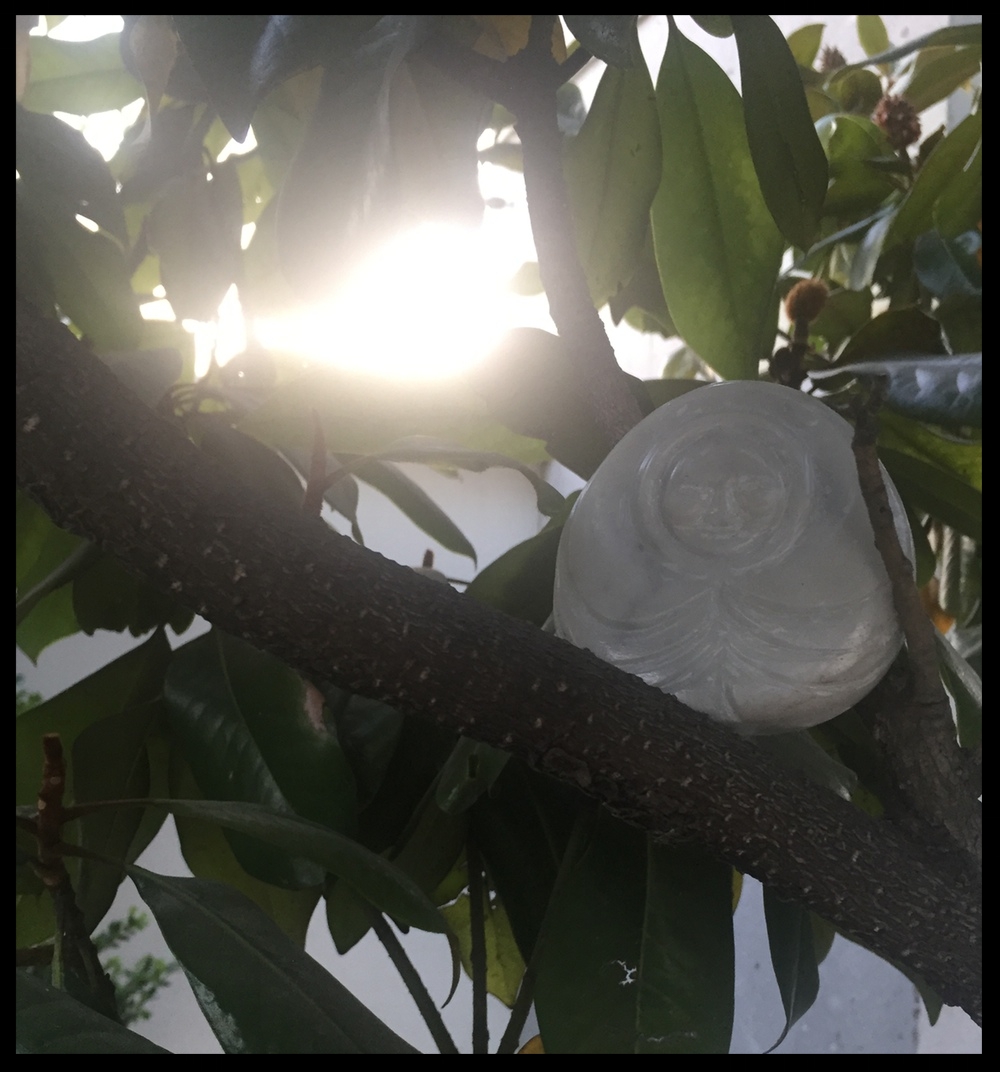Tandem Narratives Illuminate! Rastros de la Memoria Mexicana
Collaboration and Cultural Exchange: Undocumented Luna YEG-GA and MIB
Even though there is significant overlap between them, the dual narratives found in each vignette comprising this e-travel space are not direct translations. Instead, the English and Spanish cognitive journeys articulated below are independent compositions intended to promote cultural exchange and international collaboration -- two fundamental values readily available in Canada and Mexico. Meanwhile, Undocumented Luna YEG-GA marks also marks the School of One Carver's experimentation with a "new" type of rock, and the marble used for this piece was “upcycled” from a demolition or renovation of a house in Edmonton, Alberta, Canada. Unfortunately, the actual origins of the stone remain undocumented, and thus, unknown. The carving began its journey for “vignette work” with MIB in Mexico in February, 2017. Undocumented Luna YEG-GA is dedicated to thoughtful female Mexican friends of Canadians, especially those of them who value cultural exchange and collaboration across artificial North American borders.
A few years ago, MIB obtained Ph.D. in Clinical Psychoanalysis and she now maintains a private practice in Mexico. She has two daughters on the cusp of making their own mark upon the business and fashions worlds, respectively, while she is also married to an architect. Thus, MIB possesses an unique socio-cultural perspective into her own country and her e-travels also revisit her memories of Canada, further prompted by the occasional reference to the Northern nation in the Mexican media. As her opening vignette confirms, as a visitor to Canada she was struck by the country's natural beauty, and her personal reflections found in the "tandem narratives" are clearly influenced by the relationships between people and different cultures found at the crossroads of Mexico's past, present and future.
Multicultural Memories Sin Muros
The first time I went to Canada I was 17 years old. Like many teenagers I felt that I was in "no where land". Even though I traveled in a group I just did not feel that I belonged with those people. Perhaps those sentiments were particularly because of the natural surroundings I encountered during the first visit to the Northern Nation and I was overwhelmed with with the natural splendour of Niagara Falls. That feeling returned to me when I came back to me many years later during a visit to Vancouver with my husband. The landscape that I saw from our window was so extraordinary it seemed to permeate our entire hotel room.
Naucalpan, Estado de México 19/02/2017 11:45AM19°C
La primera vez que viajé a Canadá tenía 17 años y como todo adolescente me sentía perdida en la tierra de nadie, aun cuando iba en grupo no sentía que perteneciera ahí del todo. Quizás esto subrayó la sensibilidad a mi entorno y todo aquello que tocaba mi mirada adquiría magnitudes enormes. Las cataratas del Niagara literalmente se me venían encima en una brisa vigorosa casi eufórica que invadía mis sentidos, esta misma sensación me asaltó muchos años después cuando regresé ahora a Vancouver con mi esposo. El paisaje que ofrecía la ventana parecía ocupar el interior del cuarto.
This unique carving was inspired by two interesting sources. The first, I learned, may be found in the tales about “Baba Yaga”, a figure from folklore intimagely linked to a metaphor of Humanity caught within the constructive and destructive forces found in Nature. The second source of inspiration is rooted in the wisdom and contributions of women passed down through generations. Both sources of inspiration are drawn together by thoughts about time (and we should note that Baba Yaga aged a year each time she answered a question). The "Canadian" carving also caused me to ponder the expectations of people who arrive to foreign lands and how their cultural backgrounds help contribute to different perceptions of life, humanity and society. The cognitive travels, experiences and memories of women within this boundless "cyberspace" also provides an opportunity for cultural exchange across artificial national divides.
Debido a que “Baba Yaga”, figura del folclore Euroasiático contiene bajo la forma de una enigmática bruja la contradicción de las fuerzas de la naturaleza tanto destructiva como constructiva, me parece una metáfora de la condición humana. Es interesante que sea a través de una talla en piedra inspirada en dicho personaje se invite a sacar relatos de momentos significativos en la experiencia personal. Por otro lado el hacer referencia al aeropuerto de Canadá, la propuesta gira en torno a la exploración de nuevas latitudes con la emoción que despierta descubrir nuevos mundos enriqueciendo el propio. Me emociona formar parte de una serie de relatos de mujeres que viajen por el ciber espacio a manera de una Baba Yaga universal que transmite y plasma por lo pronto en este proyecto alguna experiencia que puede ser leída y reinterpretada por alguien más.
Undocumented YEG-GA made me think about the legal meaning of the term “documented” and how every step of our life has to be documented in some manner in order to prove our existence. There has to be a certificate confirming the moment of our birth and another one for our death. If we want to get married we need to be register, and, of course, when we wish to be educated we are documented at each juncture of our academic experience. But there are subtle things that cannot be captured in official documenation, including the quality of love we enjoy or our individual and collective experience that informs our sense of identity. Have we become slaves of institutions because of the obsession with official documenation?
La palabra “indocumentada” me hace pensar en la legalidad que implica el término “documentar”, como si la vida entera necesitara ser documentada y testificada objetivamente para validarla y hacer real de alguna manera. Se nos pide documentar desde el nacimiento hasta la muerte con un acta, el hecho de enamorarse y querer convivir en matrimonio, dejar un registro de aquello estudiado y atesorado en el intelecto también requiere de documentación. Y sin embargo lo más sutil y que nos define como personas escapa a la documentación, como lo sería el ir adquiriendo la propia identidad o la singular manera de amar y aprender la realidad, las modalidades de vínculo con los otros y todo aquello que nos genera la sensación de habitar este mundo. Esto me lleva a pensar si nos hemos convertido en esclavos de las instituciones.
When I read that my carving was sculpted from a piece of a larger undocumented, "upcycled" stone I thought it had something extra special to offer my own appreciation of difference, especially since its enigmatic origins implied that it could be a citizen from anywhere with a unique and original perspective.
Cuando leí que el nombre de mi escultura provenía de una casa demolida y por lo tanto el origen de la piedra quedó indocumentada, un bello mármol. Me pareció que le añadía un valor extra ya que remite a lo enigmático del interior de las cosas acrecentando su belleza y ampliando la posibilidad de ubicarla como oriunda de cualquier ciudad o lugar.
Right now in Mexico we are living a drama scripted in the exclusion of emigrant people. They are identified as “undocumented, not legal” persons. The borders we make are not only geographical but also mental, and everything that is different from "prescribed" norms represents a danger. People with diverse backgrounds are vilified and scapegoated for the supposed harm they bring to society. I wonder if certain sectors of global society are really aware of the treasures of humanity we lose each time we miss the opportunity to learn from other cultures and peoples.
Hoy día en México vivimos el drama representado en la exclusión que sufren los inmigrantes, señalados como “indocumentados y por lo mismo ilegales”. Las fronteras que hemos creado no son solamente geográficas sino mentales, cualquier cosa que no nos refleje a nosotros mismos representa una amenaza y lo ajeno en vez de que incite al conocimiento genuino nos ha llevado a la violencia y al aislamiento provocando argumentos de rechazo. Me pregunto si el ser humano se ha cuestionado acerca de la riqueza que pierde cada vez que se rompe la posibilidad de contacto con el otro, finalmente siempre es el otro quien nos salva.
Nesting People/Gente que Anida
Naucalpan, Estado de México, 18:34, 24/02/2017, 23°C
I have always thought that there is a type of people that are able “to nest”, to nurture, and to grow things. These people seem to have the natural ability to turn seeds into blooming plants. They seem to be able to capture all the nuanced shapes of a good story and by adding further reflection or “food for thought” for the topic at hand. These individuals not only are able adorn a table with welcoming “comfort food”, but also are able to add some artistic flavour to a meal at a moment’s notice. They know how to marshal style with whatever they choose to wear. And, most importantly, they appear to know how to encourage other people to reveal their inner thoughts and potential, and can teach us not only know ourselves, but also to learn what we could be if we followed our dreams. Sometimes, if we are around this type of “nester”, we are rewarded with a sense of composure. Their example helps fill the gulf that sometimes separates us from each other.
Siempre he pensado que existe gente que tiene la capacidad de anidar y hacer crecer cosas, tienen “buena mano” con las plantas, sacan provecho de una lectura extrayendo su esencia y relacionándolo con otros textos o experiencias, pueden llevar a la mesa un alimento que no solamente nutra sino que deleite, hacen de un encuentro una verdadera experiencia de intimidad emocional, saben portar lo que eligen usar, y lo más importante, poseen la capacidad de potencializar en otro ser humano sus atributos a veces apagados o escondidos, es como sin saber por qué, uno se sintiera no solo a sus anchas con esta persona sino que provoca, saca la esencia de uno mismo.
“Nesters”, as defined here from a Mexican perspective, are the kind of people that easily could be a big and leafy tree that maintains a sense of personal honour and dignity. This tree kindly invites us to rest under the protection of its natural shelter. Under its comforting shade we rest knowing that our all facets of our persona are secure.
Son esa clase de personas que pudieran ser un árbol robusto con gran follaje y sombra fresca que siempre está ahí como referencia y ante la cual se despierta un sentido del honor, que invita además a descansar bajo su amparo, sabiendo que nuestro nombre está protegido.
I could die under this tree or in the arms of that kind of person because they can provide a smooth bridge between life and death. And, without question, they help us obtain the internal warmth and wisdom that everything in our busy lives has safely settled.
Pudiera morir bajo ese árbol o en brazos de esa persona porque transmite un continuo entre la vida y la muerte, con la sabiduría de que todo está saldado y velará por albergar el propio calor.










